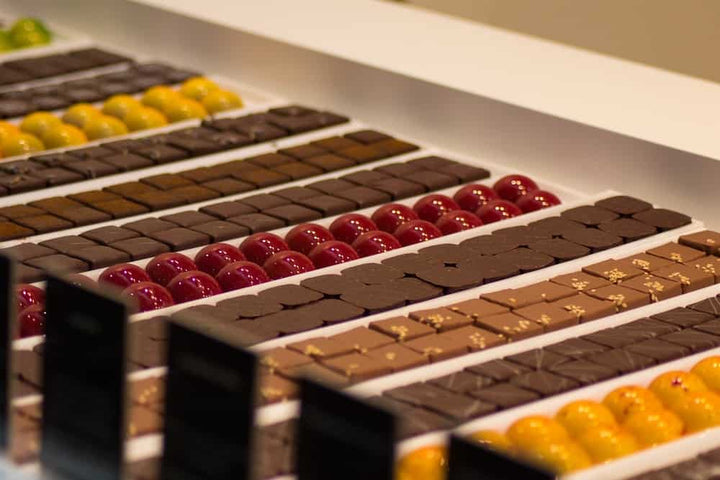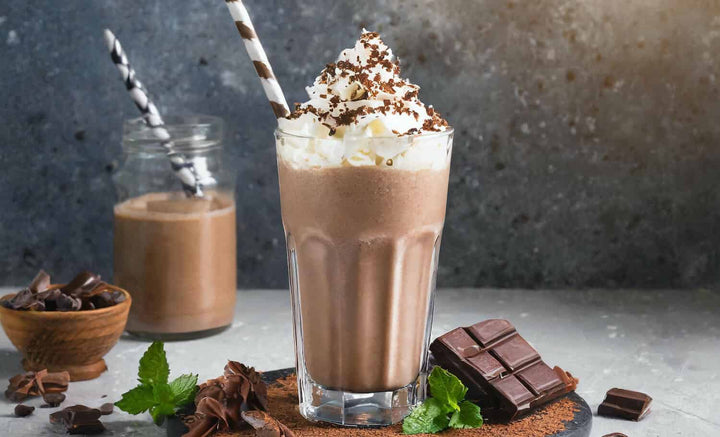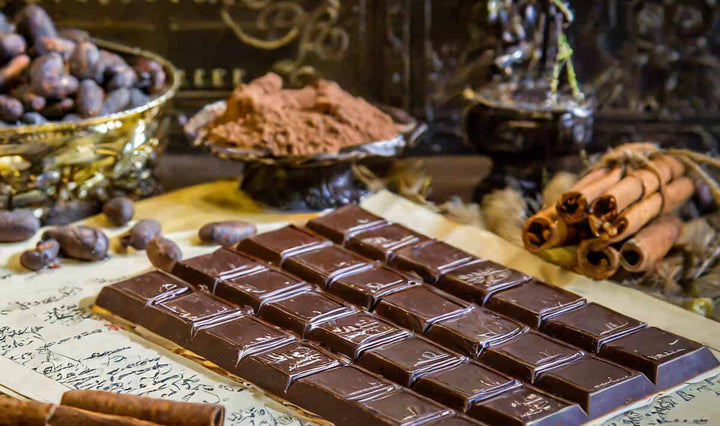In this blog post we are going to look into the process of chocolate refining.
Steeped in history and skillful engineering, it has played an integral part in shaping the way we enjoy our favourite treat.
From the humble cocoa bean to the silky-smooth chocolate we love, the refining process is a key player.
What is the Process of Chocolate Refining?
Chocolate refining is a crucial process in the production of chocolate.
After the cacao beans have been harvested, fermented, dried, and roasted, they are then ground to produce a thick paste known as chocolate liquor.
This paste contains both cocoa solids and cocoa butter.
The refining process typically involves two main steps:
-
Conching: The chocolate liquor is placed in a conching machine, a large mixer with heavy, grinding stones. As the machine works, it kneads, heats, and aerates the chocolate. This process helps to develop the flavour of the chocolate, reduce acidity, and evaporate unwanted flavors. The process can last from a few hours to several days depending on the desired quality and characteristics of the chocolate.
-
Tempering: After conching, the chocolate is tempered. During tempering, the chocolate is carefully heated, then cooled, then slightly reheated. This manipulation of temperature helps to align the fat crystals in the chocolate, ensuring a smooth texture, glossy appearance, and a nice 'snap' when broken. Untempered chocolate can have a grainy texture and a dull appearance.
The result of these processes is a chocolate that has a desirable taste, texture, and appearance.
Different types of chocolate, such as dark, milk, or white, may go through different variations of this process to achieve the desired result.
Each of these stages is crucial to the transformation of the humble cocoa bean into the glossy, melt-in-your-mouth chocolate bar we all adore.
It's a careful art and a precise science, and the magic touch of the chocolatier is what brings it all together.
Why is Chocolate Refining Important?
Chocolate refining is an integral part of the chocolate-making process and carries a profound influence on the final taste, texture, and quality of the chocolate.
Here is why refining is so important:
-
Flavour Development: The refining process aids in melding together the cocoa mass with other ingredients such as sugar and, in the case of milk chocolate, milk powder. This harmonises the flavours and intensifies the chocolate's overall taste profile.
-
Smooth Texture: Perhaps the most noticeable impact of refining is on the chocolate's texture. By grinding down the particle size of the cocoa and other ingredients to minuscule levels - often smaller than a human hair - refining ensures that the chocolate has that silky, smooth texture which melts luxuriously in your mouth. Without refining, chocolate would have a gritty and unpalatable texture.
-
Consistency: Refining also ensures consistency in the chocolate. It guarantees that each bite you take has the same taste and texture, enhancing the overall eating experience.
-
Improved Appearance: Refined chocolate has a shiny, inviting appearance and snaps cleanly when broken, characteristics that make it aesthetically pleasing.
-
Enhances Other Processes: Proper refining is essential for subsequent steps in chocolate-making, like conching and tempering, to be successful. The smooth, consistent mixture that refining produces is crucial for the development of flavour during conching and the formation of stable cocoa butter crystals during tempering.
In short, refining is an essential step that transforms the coarse cocoa mass into the velvety, delectable treat that chocolate lovers enjoy so much.
Without it, chocolate just wouldn't be the same.
What is the Difference Between Refining and Conching Chocolate?
Refining and conching are both pivotal stages in the chocolate making process, yet they serve distinct purposes and impact different aspects of the final product.
Refining: This is typically the initial stage in the chocolate production process, following the roasting and grinding of the cocoa beans.
During refining, the coarse cocoa mass is ground down into smaller particles.
Sugar, cocoa butter, milk powder (for milk chocolate), and other ingredients are added, and these are also ground down.
The primary aim of refining is to reduce the size of these particles to the point where they cannot be discerned by the human tongue, ensuring a smooth and consistent texture in the final chocolate.
Conching: Once the chocolate has been refined, it goes through the conching process.
Conching involves the heated and aerated kneading of the chocolate.
The conching machine, named for its resemblance to a conch shell, moves the chocolate mixture around continuously while heat is applied.
This has several effects.
Firstly, it helps to evaporate any remaining unwanted acetic acids, enhancing the overall flavour profile of the chocolate.
Secondly, it helps to ensure that the cocoa butter is evenly distributed throughout the mixture, again aiding texture.
Finally, it can help to develop further flavour notes in the chocolate.
Conching can take anywhere from a few hours to several days, depending on the desired quality of the final product.
In essence, while refining focuses on particle size reduction for texture, conching aims to develop flavour and perfect the chocolate's texture by evenly distributing the cocoa butter.
Both processes are fundamental in shaping the quality, taste, and texture of the final chocolate product.
What Happens After the Refining Process?
After the refining process, the next crucial stage in chocolate manufacturing is conching.
The mixture of finely ground cocoa particles, sugar, and, in the case of milk chocolate, milk powder is transferred to a conching machine.
This machine, so-named because it resembled a conch shell in its early iterations, performs several important functions.
In the conching machine, the chocolate mixture is continuously stirred and aerated under controlled temperatures.
This prolonged agitation under heat serves to release volatile acids and other unwanted flavours, which helps to improve the overall taste of the chocolate.
Conching also allows the chocolate to 'breathe', enhancing its aromatic qualities.
Meanwhile, the stirring action aids in evenly distributing the cocoa butter within the mixture, smoothing out the texture.
The length of the conching process can vary from several hours to a few days, depending on the quality of chocolate desired.
Once the conching process is completed, the chocolate mixture undergoes a process called tempering.
In tempering, the chocolate is carefully heated, cooled, and then gently reheated to precise temperatures.
This encourages the formation of stable cocoa butter crystals, giving the finished chocolate its characteristic gloss and snap, and preventing the 'blooming' of fat or sugar crystals.
The tempered chocolate is then moulded into the desired shapes (bars, pralines, etc.), cooled to solidify, and finally packaged for distribution.
Thus, the refining process marks just one stage in the careful journey that transforms raw cocoa beans into the delicious chocolate we know and love.
Where Can You Buy Top-Notch Chocolate?
If you're in the market for high-quality chocolate, look no further than us here at Whitakers Chocolates.
With over 135 years of experience in the art of chocolate making, we've spent generations perfecting our recipes and techniques, earning us a reputation for crafting exceptional chocolates.
At Whitakers, we're firm believers in quality, which is why we insist on using only the finest and most natural ingredients in our chocolates.
You won't find anything nasty or artificial here – our chocolates are 100% natural, free from any unwanted additives.
We believe that the best chocolates come from the best ingredients, which is why we take such care in selecting ours.
Over the years, we've grown our range significantly, always with an eye towards ensuring there's something for everyone.
We understand that dietary needs and preferences vary, which is why we've worked hard to develop a range that includes options for those living a vegetarian, vegan, or gluten-free lifestyle.
At Whitakers, we're firm believers that everyone should have access to great chocolates, regardless of their dietary requirements.
Whether you're after our classic dark, milk, or white chocolates, our famous chocolate wafer thins, or any of the other tempting treats in our range, you can be confident that you're getting a product that's been crafted with care and attention to detail.
We invite you to discover the difference that over a century of experience makes – try Whitakers Chocolates today.
Some treats that might tempt you!
- Dark chocolate bar infused with real sea salt and lime juice
- Dark chocolate peppermint fondant creams
- Couverture chocolate - Easymelt 55% dark chocolate mini shards - made for melting!
-
Milk chocolate wafer thins, with crunchy sugar crystals flavoured with natural sea salt and caramel
- The ultimate in luxury, our range of hand finished chocolate truffles
Some Notes From an Expert Chocolatier
As an expert chocolatier at Whitakers, I can speak to the profound importance of the chocolate refining process and the impact it has on the final product.
Every step in the transformation of cocoa beans into a delightful chocolate bar carries its weight, and refining is no exception.
In our 135 years of operation, we have learned that the refining process is critical for achieving the optimal particle size.
Too large, and the chocolate will feel gritty in the mouth.
Too small, and the chocolate can become overly dense and lose some of its delectable melt-in-the-mouth quality.
Striking the right balance through careful refining is a skill honed over time and countless batches of chocolate.
Additionally, refining serves to mix the ingredients thoroughly, which is essential for consistency.
Each bite should deliver the same delicious experience as the last.
Any variation can be jarring and detract from the enjoyment of the chocolate.
Refining also provides the groundwork for the conching process.
The more evenly the particles are distributed and the finer they are, the more efficiently the conching can occur. This, in turn, influences the development of the chocolate's flavour and texture.
So, the next time you bite into a piece of our Whitakers chocolate, remember the precision and care that went into refining it.
It's a critical part of the journey that delivers the delicious, high-quality chocolate that has made Whitakers a favourite across generations.
Final Notes On the Process of Chocolate Refining
The process of chocolate refining is a crucial stage in chocolate production that, whilst often overlooked by the consumer, plays a vital role in determining the final quality, texture, and taste of the chocolate we love.
Refining is not merely a mechanical process but rather an art form perfected over time.
It's this dedication to each step of the process that allows chocolatiers to produce a product that is consistently delightful, delivering the same incredible taste and luxurious feel with each and every bite.
It's the deep understanding of these intricate processes, such as refining, that sets apart the true masters of the chocolate world.
At Whitakers, we value the precision and patience required during refining.
This commitment to excellence in every step of the chocolate-making process is at the heart of our 135 years of success and will continue to be so as we craft the chocolates that you know and love.
So, the next time you enjoy a piece of chocolate, take a moment to appreciate the artistry and expertise that have gone into refining it, making it an experience for all your senses.











